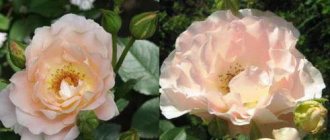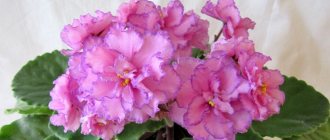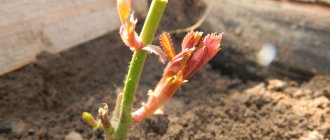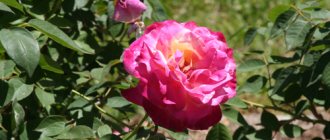History of the variety's creation
This variety of roses began to be bred at the beginning of the last century, when breeders from different countries of the European continent began to cross old popular varieties of roses with rose hips, or “flower queens” from different groups with each other. It is almost impossible to say exactly who created the world's first floribunda rose. But some flower growers and specialists give the palm to the German breeder Peter Lambert, while others give the palm to the Danish specialist Svend Poulsen.
Photo of floribunda freesia rose flowers
But one thing is known - the first representatives of a new class of roses - floribunda - were obtained as a result of crossing polyanthus and tea "flower queens" with each other. From the former, new types of roses received resistance to disease, long-lasting and abundant flowering, and from the latter, greater height of shoots and large flowers.
Later, when developing new varieties and hybrids of floribunda roses, breeders took musk, Chinese and a number of other varieties of this flowering shrub as a basis.
The variety of colors of rose petals in this category is amazing - almost the entire color gamut of flowers and their shades.
VARIETIES OF BEAUTIFUL FLORIBUNDA ROSES!
Floribunda rose Rumba Floribunda rose Midsummer "Midsummer" Floribunda rose Arthur Bell
Interesting!
The official ancestor of most roses of this variety is the American breeder Eugene Berner, who over the course of his work has bred more than 55 varieties of floribunda, which are still popular among flower growers from around the world.
The Floribunda Freesia rose was bred in 1973 by German breeders. It was obtained by grafting, and the following varieties of roses are usually used as rootstocks: Cattail or horsemeat. It can also be grafted onto ordinary rose hips.
Due to its high resistance to frost, the Freesia rose can be grown in most Russian regions, which is very important, for example, for Siberia or the Urals, where in winter many perennials simply freeze out due to cold weather.
Freesia propagation
Melba apple tree: description of the variety, photos, reviews from gardeners
The traditional method of propagating freesia is vegetative, using daughter bulbs
From 3 to 5 daughters are formed on one bulb, but it is important to separate them correctly. In the fall, after digging up the bulbs, it is forbidden to separate the daughter bulbs; they will not survive the winter
Store the bulbs for storage and only divide the planting material before planting. Propagation of freesia by bulbs is used by most gardeners. There is another way, propagating freesia by seeds. It is less popular due to the frequent loss of varietal characteristics, lengthy and labor-intensive actions, often wasted due to low seed germination.
Growing freesia in open ground is a fascinating process with exciting and unique results. Lush and colorful flowering, along with a wonderful aroma, will captivate every gardener who has not yet encountered the plant with his own eyes.
Rose Freesia: description of the variety and its characteristics
This rose is a perennial shrub with well-branched shoots and a tree-like central trunk.
Freesia rose bushes are of medium height, well-leafed shoots can reach a height of 0.6-0.75 m. The foliage is thin, round in shape with pointed tips and slightly jagged edges. The central vein is clearly visible, its color is dark emerald, as is the color of the leaf blades.
Brief overview of the floribunda freesia rose - video
The roots of an adult rose are powerful and well branched.
Interesting!
The flowering of the Freesia rose begins in the second ten days of June, its duration is almost until the first frost. The blooming buds are collected in racemose inflorescences, each of which can bloom up to 8 flowers almost simultaneously.
The buds are densely double, they can be up to 10 cm in diameter, the shape of the blooming flowers is cup-shaped. The color of the petals of the Freesia rose is bright yellow, sometimes lemon.
Photo of a floribunda freesia rose bud
During the flowering period, this shrub looks very beautiful and, thanks to the abundance of bright lemon flowers, is visible from afar. Rose Freesia is unpretentious to growing conditions; it grows and blooms equally well in the sun and in light shade. The Freesia rose variety is frost-resistant and can easily tolerate cold temperatures down to -28 degrees Celsius.
. The bushes also calmly tolerate spring return frosts with air temperatures down to 0-2 degrees.
Special mention should be made about the resistance of this floribunda rose to major diseases.
Freesia is practically not affected by the following diseases:
- viral in nature;
- black spotting;
- powdery mildew.
But the resistance of this perennial to scab and fusarium is below average.
Description of the plant
Floribunda variety "Freesia" has a number of synonymous names. Many gardeners know it as:
Description of appearance
- The height of upright compact bushes is 60-70 cm (in the shade the shoots can stretch up to 80 cm), and their diameter is no more than 60 cm.
- The shiny, leathery leaves are medium in size and dark green in color, remaining rich until the first frost.
- Semi-double cup-shaped flowers, painted golden yellow and collected in brushes, consist of many (30 to 35) loosely arranged petals with wavy edges (see photo). Fully opened flowers display an open center and a tuft of bright red stamens, giving them a flirty appearance. Each flower cluster contains from 3 to 8 large (up to 10 cm in diameter) flowers.
- Floribundas of the "Freesia" variety have a very pleasant and rather strong fruity aroma, reminiscent of the smell of hybrid tea roses.
- The flowering period, striking in its luxury and abundance, is very long: from the first days of June until the first autumn frosts. As a rule, it occurs in two waves, separated from each other by a two-week pause.
- The variety is characterized by high resistance to rain and powdery mildew; Resistance to black spot is average.
Application in landscape design
- The length of the stems, ranging from 60 to 75 cm, is quite sufficient to use roses of this variety to make magnificent bouquets, so they can be grown for cutting.
- In a small area, the area of which is not sufficient for setting up a rose garden, floribundas of the "Freesia" variety can be used to create a ridge - an elongated flower bed running along the garden path.
- Landscape designers use these bright roses to create group plantings (mixborders), flower beds and borders, combining them with more modest plants, against which the beauty of floribundas is revealed with maximum power.
- The flower bed, the front edge of which is decorated with luxuriously blooming floribundas of the “Freesia” variety, looks especially impressive.
Advantages of the variety
Experts include the main advantages of the Freesia rose variety:
- beautiful shape, large size and bright colors of flowers;
- abundant, long-lasting flowering;
- high resistance to cold, as well as resistance to spring cold snaps, therefore Freesia is grown in many regions with a short summer season and cold winters;
- high immunity to viral infections, black spot and powdery mildew;
- flowers are resistant to rain;
- unpretentiousness to growing conditions, it is possible to grow roses on poor soils and in the shade.
Features and advantages of floribunda roses - video
Among the disadvantages, it should be noted the low resistance of the flower to fusarium and scab, so it is necessary to carry out a number of preventive measures to prevent their development in the Freesia rose. Flower growers also note that the break between waves of flowering is quite long.
Reviews
Reviews from flower growers who have ever grown floribundas of the Freesia variety in their garden are full of enthusiastic assessments. In their opinion, the advantages of the variety are presented:
- the extraordinary brightness of the flowers, contrasting with the dark green glossy leaves;
- the presence of a strong aroma;
- luxury and abundance of flowering;
- unpretentiousness to growing conditions;
- resistance to diseases.
The only drawback of these luxurious roses is the rapid shedding of flowers, however, thanks to this feature, floribunda bushes of the Freesia variety always maintain a neat appearance.
Floribunda roses, or free-blooming roses, are loved by gardeners around the world. Representatives of this variety bloom continuously almost all summer and autumn, are highly resistant to diseases, are unpretentious in care, and their flowers have a beautiful shape and brightly colored petals.
One of the best representatives of floribunda roses is the Freesia rose. The main positive qualities of this “queen of flowers”, the nuances of cultivation and care, beautiful photos, reviews from flower growers and much more will be described below.
Diseases and pests of roses
It is not always possible to create conditions for the Freesia rose that completely guarantee the absence of diseases and the appearance of pests. Although this flower is resistant to powdery mildew, black spot and a number of viral infections, there are a number of diseases to which the immunity of this plant is low.
VARIETIES OF DELICATE AND BEAUTIFUL ROSES>>>
Park rose Louis Odier Rose “Mondial” Rose Frederic Mistral
Among the diseases, this perennial can be damaged by:
- Scabby.
To combat the disease, an alcohol tincture of iodine is used - it is used to treat damaged areas of foliage and stems. You should also treat the bushes twice (with an interval of a couple of weeks) with a solution of Fitosporin, Khoma or Bordeaux mixture. - against fusarium
- Fundazol or Maxim (as well as similar drugs). A solution of these substances is used to treat the vegetative mass of the rose twice with an interval of a couple of weeks. - To cope with chlorosis (yellow foliage),
it is necessary to apply fertilizer containing nitrogen to the tree trunks of the bush twice.
Photo of floribunda rose Freesia
Insect pests can also attack this flower:
- Aphids,
which can be combated with the following drugs:
Actellik, Antio, Karbofos, Rogor, Metathion.
Treating roses with solutions of the following insecticides can help
against leafhoppers Ditox, Tagore, Tzipi.
The bushes should be sprayed twice, the interval between treatments is 10 days.
Akrex, Izofen, Omaytom help well against spider mites You can also use other acaricidal preparations for spraying.
Features of care
The entire procedure for caring for the plant involves timely watering, fertilizing, loosening and pruning. Thanks to this set, it is possible to ensure high-quality flowering of the plant for more than one year, which is the main indicator of successful floriculture.
Watering
Freesia is a moisture-loving plant, so the bushes are watered systematically. Since the root system of the plant is capable of penetrating into the lower horizons, it is best to water rarely but abundantly in order to completely wet the soil to the lower horizons. In spring and autumn, the procedure is carried out once a week, in summer at least 2 times a week. The last time moisture is added to the beds is two weeks after the bush has flowered. Regardless of the season, each average plant requires 15–20 liters of water.
For watering, a so-called trunk circle is created around the bush - a small depression around the base of the bush. Moisture is introduced into this area; irrigation of the green mass is not recommended. In this case, watering can create excessive moisture, which is an ideal environment for fungal growth. The ideal period for the procedure is early morning. During the day, particles of spilled moisture on the foliage can cause sunburn of the tissues, and evening watering leads to excessive dampness in the area.
Fertilizer application
As the bushes grow and develop, they definitely need feeding. The beds are fed systematically, the procedure is first carried out 14–20 days after planting, and then every spring, before the buds appear. To do this, use any high-nitrogen mixture (urea, nitroammophosphate, ammonium nitrate).
The second feeding of the flower is done in early July, using superphosphate and potassium nitrate. If possible, additionally feed Freesia in the fall, after flowering, for this purpose manure, peat, compost and other organic mixtures are added to the beds.
Weeding and loosening the soil
One of the most important flower care procedures is timely weeding combined with loosening. Carry out this type of care regularly. For the first time, the soil is weeded 3 weeks after planting the seedlings, and then every week, to a depth of at least 10 cm. This is the only way to destroy all weeds and supply the soil with oxygen.
Trimming
Pruning is the only procedure that helps Freesia fulfill its main goal: to decorate the garden plot. In addition, without timely implementation of the procedure, it is almost impossible to achieve particularly large flowers, since the plant will actively spend energy on the formation of extra shoots. And this is often the main reason for the decrease in activity and duration of flowering of the bush. For the first time, a young seedling is pruned the next year after planting, and then the formation of the plant is carried out once a season. The optimal period for this is considered to be early spring, before buds appear on the bushes.
There are three types of pruning:
- Strong - no more than 2-4 buds are left on each shoot; it is used to rejuvenate a mature bush.
- Moderate - up to 7 buds are allowed on each branch; this procedure better ensures decorativeness, as well as early flowering.
- Weak - used in summer to remove faded inflorescences and dried shoots.
In addition, the so-called sanitary pruning must be done; the second half of autumn is considered the best time for it. At this time, old, damaged and excess shoots are removed. This allows the bushes to successfully enter the period of winter anabiosis, as well as form an elegant, decorative crown.
Shelter for the winter
Cover Freesia as necessary, if the crop is grown in a cold climate with winter frosts of more than –10°C. The procedure is carried out before a sharp cold snap, in the second half of November. Young small bushes are laid on a flooring of boards or branches and secured to the ground with metal rods.
The root ring of the flower is spudded, and the plant itself is covered with a layer of sawdust, pine needles, husks or other natural materials. The top of this flooring is covered with spunbond in 2-3 layers. Tall bushes are not laid on the soil; instead, the plant is tightly wrapped with spunbond.
Rose floribunda Freesia: planting flowers
These beautiful roses should be planted in a place where they can be admired from different parts of the garden. In addition, Freesia also feels great in partial shade, so it can be given a place almost anywhere in the garden.
Photo of floribunda freesia rose in the garden
When choosing a site, you need to remember that a rose can be illuminated by sunlight in the morning and evening, but on a hot afternoon it is better for a light shadow to fall on the bushes - under the hot sun the buds fade and fade faster. In addition, foliage and petals can get burned due to the heat.
The lowland is also not for these flowering bushes - cold air accumulates there, harmful to the rose.
Although this perennial is unpretentious to the soils on which it grows, it still feels more comfortable on black earth or loamy soils.
in which a sufficient amount of fertilizer has been added. Good breathability and looseness are also positive qualities of the soil, thanks to which the rose will bloom more actively.
Useful article:
Soil salinization How to improve the soil, its fertility, composition, structure
If the site has solid alumina, then it is better to add organic matter (humus, compost, peat), as well as coarse river sand, to it in the fall before digging.
Sandstone loses moisture too quickly and quickly heats up under the sun's rays, so experienced gardeners add a large amount of clay soil to it. Humus and turf soil. The acidity of the soil for Freesia roses should be neutral or slightly alkaline. For acidification, it is better to add peat, and reduce the acidity with wood ash or lime.
Since the roots of this rose go deep into the ground, the groundwater level should be no closer to the soil surface than 1.5 m, otherwise the bushes may develop black spotting.
Rules for growing floribunda roses - video
Important!
In regions with short summers and cold winters, it is better to plant the Freesia rose in a permanent place in the spring - from the last ten days of April to the last ten days of May.
In autumn, Freesia roses can only be planted in September so that they have time to take root and get stronger before the onset of winter.
The depth of the planting holes is about 0.6 m.
A layer of drainage material up to 8-9 cm thick is laid on the bottom, then a layer of nutrient substrate, from which a mound is formed in the center of the hole.
Photo of preparing a planting hole for a rose
Before planting, seedlings should be placed in a solution of a root growth stimulator for half an hour, then the roots should be trimmed, removing damaged ones and shortening those that are too long.
A Freesia rose seedling is placed in the center of the hole, the roots are straightened, and the hole is filled with soil. The root collar is buried 2.5-3 cm into the soil. Then up to 10 liters of water are added to each plant. The tree trunk circles are mulched with humus on top.
Features of growing in open ground
Often, cultivating Freesia does not cause much trouble, so even a novice gardener can grow it on the plot. But you can get a healthy and abundantly flowering plant only after careful preparation. It includes methods for soil cultivation and compliance with the required planting dates.
Landing dates
Roses are planted in early spring, before buds appear. The optimal period for planting a bush occurs after a full spring thaw occurs, with a temperature range of +10...+15°C. In the temperate climatic region, this time is observed throughout the beginning of May, in the south in the first half of April.
Selecting a location
The best place for cultivating a flower is considered to be a well-lit and dry area, away from high humidity and tree-like vegetation. However, the bush can be successfully grown in the first tier of tall vegetation or partial shade. It is important to take into account the fact that the flowering of such bushes will be less active, and the flowers of shaded bushes often form no more than 5–6 cm in diameter.
Important! It is not recommended to plant freesia in a draft; this negatively affects the plant’s immunity and also creates favorable conditions for the development of aphids.
When choosing a place to plant Freesia, it is important to take into account the composition of the soil mixture on the site. The species grows and develops better on highly nutritious fertile soils. Leached chernozem is suitable for this, while swampy and peaty substrates are undesirable for bushes, as they often inhibit their growth and flowering. Poorer and denser substrates are enriched with humus or peat, but the pH of such soil should be within 6–7 units.
Preparatory work
The flower requires minimal preparatory work. However, at this stage the plant often receives a valuable charge, without which the chances of its effective rooting are rapidly reduced. In order to get graceful flowers in the summer, you need to approach the procedure especially carefully.
Soil preparation
Soil preparation begins long before seedlings are planted. Beginning in the fall, in the first half of November, the area under future plantings is carefully dug up to a depth of at least 30 cm. Thanks to this procedure, all kinds of pest larvae hiding in the soil are exposed, which in the spring sharply reduces the activity of their population.
At the same time, it is necessary to clean the soil from the remains of any vegetation that is a reservoir of dangerous infections. At the end of March, the soil is dug up again, and then the area is carefully leveled. To improve the nutritional value of the substrate, the soil is enriched with a mixture of 9 liters of humus and 1 liter of clay. Additionally, 15–20 g of superphosphate is added to the mixture.
Preparation of seedlings
About a day before planting, seedlings must also be prepared. They are soaked in clean, settled water at room temperature. This is necessary so that the plants are saturated with valuable moisture, which activates their metabolism. As a result, the procedure helps Freesia take root safely in just a few weeks. Only the root system is soaked in water; soaking the stem can cause putrefactive lesions on the seedling, which almost always threatens its death.
Did you know? Roses are one of the oldest plants on the planet. According to archaeological finds, this species existed on the planet 50 million years ago.
Technology and depth
Bushes are planted singly or in mass plantings. In the second case, the plants are planted in a row or staggered manner, at a distance of 50–100 cm. An individual hole, 50 cm deep and about 45 cm in diameter, is created for each plant on the site. If the plant is not grown on nutritious black soil, each hole is filled with a special nutrient substrate , consisting of peat, leaf soil and clay (2:2:1). After this, the plantings are well moistened. As soon as the moisture is absorbed, the bushes are mulched (layer thickness 5–10 cm) with sawdust, spruce needles, tree bark, husks or other natural materials.
Further care for Freesia roses
In the future, you need to carry out the following measures to care for the Floribunda Freesia rose:
- observe the irrigation regime;
- loosen tree trunk circles;
- remove weeds;
- apply fertilizers;
- carry out pruning.
In autumn, it is necessary to prepare roses for the onset of winter.
Although the Freesia rose is resistant to short periods of drought, it is better to water regularly.
VARIETY OF BEAUTIFUL ROSE CLIMING!
Rose variety Gloria Day
Important!
Water for irrigation should not be cold. In warm weather, add 1.5-2 buckets of water to each plant every 3-4 days. By the last ten days of August, the number of waterings is reduced, and at the beginning of autumn they are stopped completely.
In the first season, it is better to remove all emerging buds - the bushes should begin to grow, and the root system should grow well and become stronger, and early flowering will weaken the young plants. In early August, a pair of flowers should be left on each stem, on which fruits will then form. After this procedure, rose bushes will ripen better in the future, will not freeze in winter, and will bloom actively next summer.
Pruning freesia rose bushes
The best time for pruning is early spring, before the sap begins to flow in the shoots.
Be sure to leave those shoots on which flowers will appear in the current season.
Photo diagram of the degree of pruning of roses
Heavy pruning, in which no more than 4 buds are left on each shoot, is carried out to rejuvenate plants,
as well as after planting seedlings in a permanent place.
Average pruning of a Freesia rose includes refining the vines with the removal of excess, diseased and damaged shoots.
You should also trim the tops of the main shoots to encourage the growth of side stems.
Photo of floribunda rose pruning scheme
In autumn, it is necessary to carry out sanitary pruning of Freesia rose bushes,
in which young, non-lignified and weak stems, part of the shoots growing inside the bush are removed to prevent it from thickening, as well as all damaged branches.
During the summer, you should regularly remove all fading buds so that new flowers appear faster.
Rose Freesia: plant nutrition
In the first season, it is not necessary to fertilize the planted Freesia rose bushes,
if the soil was well fertilized during planting. Subsequently, in the spring, nitrogen-containing fertilizers are applied to these flowers, and in the summer and autumn, fertilizers containing superphosphate and potassium salts are applied.
CHOOSE BEAUTIFUL FLOWERS>>>
Calibrachoa Aquilegia Subulate Phlox
Preparing freesia roses for winter
The main thing when preparing Freesia rose bushes for winter is to cover the plants.
Such work begins when the thermometer drops to -5-7 degrees Celsius. The bushes are trimmed and the base is hilled up - better with earth than with other available materials.
Photo of covering roses for the winter
Spruce branches are placed between the plants and on top of them. Then greenhouse arcs are installed, on which the covering material is stretched, and polyethylene on top, leaving slits in the sides for ventilation.
Rose blossom
Areca palm - how to care for the plant
The rose blooms long and profusely. In the off-season it takes a break, after a few weeks the second wave of flowering begins.
Period of activity and rest
The rose blooms in June and delights with its beautiful flowers until frost. The first flowering is more abundant than the second one.
Freesia blossom
Care during and after flowering
After the Freesia flowers, the leaves and stem are trimmed. The bulb is left in the ground for 45 days to allow new bulbs to form. During this time, watering does not stop.
What to do if it doesn’t bloom, possible reasons
If Freesia does not bloom, it means that mistakes were made in growing. Among them are:
- diseased tubers were planted;
- excess or lack of fertilizers;
- the bush is infected with disease or damaged by insects;
- wrong landing site and other reasons.
Rose Freesia: reviews from those who grow
Olga, 45 years old, Yaroslavl: In my garden in the recreation area, I made two lawns with soft emerald grass and planted several freesia rose bushes in each. When they began to bloom, it turned out so beautiful: against the background of bright green grass there are large yellow spots of the flowers of this rose. I always cover the rose for the winter, and during the summer I don’t forget to regularly water and feed it. My roses have not yet been damaged by disease.
Natalya, 50 years old, Volzhsky: My garden plot is not too large, so there are not enough sunny areas for all the plants. And I would like to plant some flowering perennials near the house, where, unfortunately, partial shade reigns. I was told to plant a Freesia rose there, which can grow and bloom beautifully in such conditions. Now in front of my country house there have been 3 bushes of this variety growing for three years and actively blooming until October!
Svetlana, 55 years old, Chelyabinsk region: For a long time I was looking for a variety of roses that would not freeze in winter in our climate. I planted these flowers in front of my house several times and covered them well, but they all froze until spring. And so I planted Freesia. I can say that this rose feels great in the summer, it doesn’t get sick, although since we fought against aphids, we dealt with it without any noticeable losses. In winter I covered it as written in the instructions. In the spring I opened the bushes and was surprised - not a single shoot died out.
The floribunda variety Freesia will definitely decorate the flowerbed and the entire garden plot, you just need to pay attention to it during the period of growth and flowering.
Recently searched:
Features of care
Caring for rose bushes consists of:
- in timely watering and weeding;
- in loosening and mulching the soil;
- in regular fertilizing,
- in the correct trim.
Watering
Floribundas need a lot of water, and this need is not the same at different phases of development.
- Water is most important for a plant during the period of bud break, the appearance of leaves and shoots, and also at the end of the first wave of flowering, when new shoots begin to grow. If the bush receives insufficient nutrients and water, the young shoots on it will be weak, and the flowers will be frail and underdeveloped.
- During the period of intensive development of floribundas, the rose garden should be watered at least once a week (at the rate of 10 liters per bush), using settled water. To water rose bushes, it is better to use a watering can with the nozzle (sprinkler) removed. The stream must be directed into a shallow hole located at the very base of the bush, trying not to hit the leaves.
- It is better to avoid watering by sprinkling, since with this method the roots of roses receive much less water than they need. Superficial (even daily) watering is also pointless.
- On a hot summer day, you should never water roses in the scorching sun: this can cause burns to the tender leaves. It is necessary to wait until evening, and the watering time should be chosen in such a way that before nightfall the leaves on the bushes have time to dry well. At night, the risk of fungal infections affecting wet foliage increases significantly.
- The intensity and frequency of watering depends on the time of year. In late summer and fall, overwatering can harm rose bushes. Excess moisture stimulates further plant growth; As a result, young shoots that did not have time to ripen by the time of the onset of cold weather are most often damaged by frost. That is why it is better to stop watering floribundas in September: the plants have enough moisture entering the soil along with natural precipitation. The exception is too dry autumn. In this case, moderate watering is necessary to saturate the root system of roses with the moisture they need for successful wintering.
Home care
Freesias require careful care: they are demanding in terms of growing conditions. Ring supports are installed on each pot: fragile stems can break under the weight of the inflorescences.
Freesia in a pot with supports
Watering
The flower is watered with warm, settled water. The top layer of soil must be dry before watering. Constantly wet soil can cause corms to rot.
Top dressing
During budding and flowering, plants are fed once every 2 weeks with mineral fertilizers for flowering plants. After flowering, for full ripening of the bulb, freesia is fed with a superphosphate solution every 14 days.
Loosening, mulching
For home breeding, surface loosening is recommended to prevent damage to the bulb scales. By mulching the top layer with peat, you don’t have to loosen the soil.
Pinching, pinching, pruning
The plant does not need pinching or pinching. It is necessary to trim wilted flowers in a timely manner. After flowering, there is no need to rush to prune the plant. In 2–3 weeks, freesia will form young tubers in the soil. After this, she can throw out flower stalks again, and there will be a second wave of flowering. When the bush has completely faded, the leaves and main stem are cut off at the base of the ground.
Important! The bulb should remain in a pot of soil for some time after flowering.
Transfer
After flowering, the tuber is kept in the soil for 1–1.5 months, watering periodically. After time, it is dug up, cleared of soil, dried for several days and put away for storage.
Diseases and pests
If the rules for caring for the plant are not followed, freesia may develop fusarium, scab, or various rots. If fungal diseases are detected, the plant is treated with fungicides. Disease prevention is done by watering with warm water and avoiding stagnation of water in the pot. Viral diseases cannot be treated; the affected bush must be removed.
At home, pests may appear on freesia; spider mites, thrips, aphids. The plant is sprayed with insecticides against parasitic insects.
The work expended will not be in vain. A pot of blooming fragrant freesias will leave few people indifferent. A flowerpot with flowers can be a wonderful gift for Tatiana's Day and the holiday of March 8th.
Selection of location and conditions of detention
- The health of roses largely depends on how correct the choice of place for planting them was. Being light-loving plants, Freesia floribundas grow well in sunny areas, but bushes exposed to the sun all day will fade much faster. Rose petals grown in open sunny areas in hot southern climates often suffer from burns. To create optimal growing conditions for roses, experienced gardeners recommend placing them in such a way that the bushes are in partial shade in the afternoon.
- The area where you plan to set up a rose garden should be well ventilated, since good air circulation, which promotes rapid evaporation of moisture, significantly reduces the likelihood of attacks by insect pests and the occurrence of fungal infections.
- You should avoid setting up a rose garden in a low-lying area, since the cold air that stagnates there can provoke the development of dangerous diseases.
Soil requirements
Floribunda variety "Freesia" is a fairly unpretentious plant that does not place high demands on the soil, so even novice gardeners can grow it. However, they need to learn the following:
- Roses of this variety will grow best in an area with fertile, light and breathable soil that can provide their root system with the necessary amount of nutrients, moisture and air.
- Light sandy soils that allow water to pass through like a sieve have too few nutrients. Plus, on hot days they can get very hot. To improve the soil in such an area, clay, peat-manure compost (or humus) and turf soil are added to it.
- If roses are grown in an area with heavy clay soil, the situation can be corrected by adding sand, humus, compost and peat.
- The soil in the rose garden should be slightly acidic (the optimal acidity level – pH – should not exceed 6.5). You can reduce soil acidity using lime and wood ash; if the soil reaction is alkaline, a certain amount of manure or peat is added to it.
- Since roses have a fairly powerful root system that goes deep into the soil, growing them in an area with a high level of groundwater is completely unacceptable (this is fraught with the development of black spotting). For roses to feel comfortable, groundwater must lie at least 1.5 meters from the surface of the earth.











